Could make sense to alter this topic ‘subject’ line…
This is a new TTGO LoRa32 V2.1.6 with SX1262 radio.

Datasheet (in Chinese) for the HPD16A module that was custom designed by HPDTeK upon request from LilyGO company (owner of TTGO brand) and SoftRF open source project.